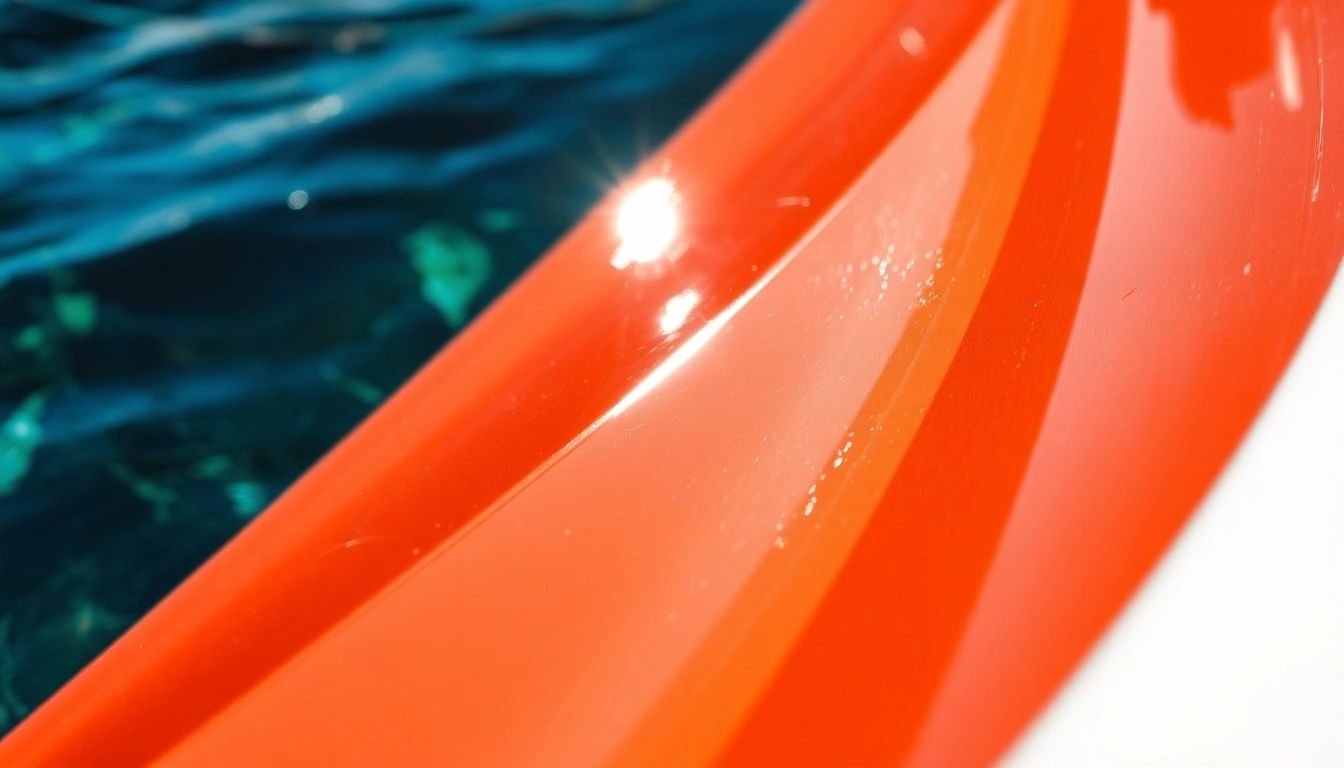Understanding Boots Versiegelung: Basics and Benefits
What Is Boots Versiegelung and Why Is It Essential?
Boots Versiegelung, or boat sealant, plays a vital role in maintaining the longevity and appearance of marine vessels, especially boats and other watercraft. It forms a protective barrier over the gelcoat, paintwork, or fiberglass surfaces, shielding them from environmental assaults such as saltwater, UV radiation, pollutants, and physical wear. This sealant not only enhances the aesthetic appeal by adding a glossy finish but also significantly extends the lifespan of your boat’s surface by preventing damage and deterioration over time.
Applying a high-quality Boots Versiegelung is an investment that preserves your boat’s value, reduces maintenance costs, and ensures optimal performance on the water. Proper sealing prevents the penetration of water, which can cause underlying damage, and helps maintain a smooth, shiny surface that resists dirt and algae buildup.
Types of Marine Sealants and Their Applications
There is a variety of marine sealants designed for specific surfaces and intended uses. Key types include:
- Polymer-based Sealants: These are the most common, offering excellent adhesion, flexibility, and long-lasting protection. They are suitable for gelcoat, fiberglass, and painted surfaces.
- Ceramic Coatings: The latest advancement providing superior hydrophobicity, shine, and scratch resistance. Ideal for high-end applications where maximum protection is desired.
- Wax-based Sealants: Often used for quick polishing and short-term protection, but less durable than polymer or ceramic options.
- Liquid Sealants: Easy to apply and provide an even coating; perfect for routine maintenance.
Choosing the correct sealant depends on surface material, environmental conditions, and desired durability. For example, gelcoat surfaces benefit from specialized marine gelcoat sealants, while painted hulls require compatible products that do not degrade the underlying paint.
Key Benefits: Durability, Shine, and Environmental Resistance
When properly applied, Boots Versiegelung offers multiple benefits essential for marine maintenance:
- Extended Durability: High-quality sealants form a resilient barrier that withstands harsh conditions—UV rays, salt, water splashes, and abrasion—thus reducing reapplication frequency.
- Enhanced Shine: Merely applying the sealant revitalizes the surface, imparting a glossy finish that enhances the boat’s aesthetic appeal.
- Protection Against Environmental Factors: Sealants resist the accumulation of dirt and algae, making cleaning easier and keeping the surface looking pristine.
- Oxidation and Corrosion Resistance: They prevent oxidation of gelcoat and metal parts, safeguarding against corrosion especially in saltwater environments.
Investing in a high-quality Boots Versiegelung ensures your vessel maintains high performance and visual appeal even after prolonged exposure to challenging conditions.
Step-by-Step Guide to Applying Boots Versiegelung
Preparing Your Boat Surface for Optimal Results
Preparation is crucial for effective sealing. Begin by thoroughly washing the boat with a dedicated marine cleaner such as the BCC Power Cleaner 1L. Use a soft, microfiber towel or wash mitt to remove dirt, salt, and algae. Avoid using harsh abrasive products that could damage the gelcoat or paint surface. After cleaning, inspect for any existing damage or oxidation. If necessary, sand and repair surface imperfections with appropriate polishing compounds like BCC Power Polish for optimal adhesion and smoothness.
Dry the surface completely using microfiber towels to prevent water spots and ensure the sealant bonds properly. Also, remove any residual wax or old sealants with a mild solvent or dedicated stripping product, ensuring that the new coating adheres seamlessly.
Applying the Sealant: Techniques for Even Coverage
Apply Boots Versiegelung according to the manufacturer’s instructions, typically with a foam applicator or microfiber cloth. Use small, overlapping sections to prevent missing spots. For larger surfaces, employing a dual-action polisher or a foam pad can ensure even application and reduction of streaks and bubbles.
Work in a shaded area or during cooler parts of the day to prevent rapid drying or sweating on the surface. Apply the sealant in thin layers to avoid excess buildup, which can lead to cloudiness or uneven gloss. Allow the coating to cure for the specified time, usually 15-30 minutes, and then buff gently with a clean microfiber towel for a high-gloss finish.
Post-Application Care and Maintenance
After the initial application, regular cleaning and maintenance prolong the life of the sealant. Use mild, marine-specific cleaning products like BCC Power Cleaner and soft microfiber towels for frequent washing. Avoid abrasive brushes or harsh chemicals that could degrade the sealant layer.
Inspect the surface periodically for signs of wear or dullness. Reapply the sealant every 12-24 months or as recommended, especially after long exposure to UV or saltwater. Using products like BCC Towels Vorteilspack makes maintenance easier by providing highly absorbent and gentle cloths designed for delicate Marine surfaces.
Choosing the Right Boots Versiegelung Products
Factors to Consider: Surface Compatibility and Longevity
When selecting a Marine sealant, consider the compatibility with your boat’s surface—fiberglass, gelcoat, painted surfaces, or metals. Durability is another key factor; high-performance products like Gtechniq’s Ceramic Top Coat offer extreme hydrophobic and scratch-resistant properties. Longevity varies among products, so opt for a sealant that matches your usage frequency and environmental exposure.
Assess the ease of application, curing time, and whether additional tools like foam pads or sprayers are needed. For example, the BCC Snow Foam Gun simplifies applying foam-based sealants or cleaners, enabling uniform coverage and efficient work.
Top-Rated Products and How They Compare
Among popular choices, the MARINE SEALANT MS-3000/60 V2 offers excellent protection with easy application, while products like BCC Power Sealer provide a durable, long-lasting protective film. The Gtechniq Ceramic Top Coat brings ceramic technology for maximum surface resistance, albeit at a higher price point. For quick touch-ups, liquid sealants such as BCC Power Sealer are practical and effective.
Consider customer reviews, performance tests, and expert recommendations when selecting your ideal product. A balanced choice often combines ease of use, durability, and value for money.
Expert Tips for Maximizing Protection and Shine
Ensure meticulous surface preparation before applying any sealant. Multiple thin coats can enhance protection more effectively than a single thick layer. Use high-quality applicators and microfiber towels for buffing to achieve a mirror-like finish.
Keep environmental factors in mind—apply in shaded, low-humidity conditions and follow curing times strictly. Store sealants properly in a cool, dry place to maintain their efficacy. Regular cleaning combined with timely reapplication will preserve both shine and protection longer.
Common Challenges and How to Overcome Them
Dealing with Uneven Application and Bubbles
Uneven coatings or bubbles often result from applying thick layers or working in unsuitable conditions. To mitigate this, always work in thin, overlapping coats in ambient temperatures between 15°C and 25°C. Use a quality applicator—such as a foam or microfiber pad—and ensure the surface is free from moisture and dirt.
In case of bubbles, lightly buff the surface once the sealant cures, then reapply a thin layer if necessary.
Removing Old Sealant and Preparing Surfaces
Old or degraded sealants can compromise new applications. Use a dedicated stripping solvent or mild abrasive polishing compounds like BCC Power Polish to remove stubborn residues. Proper surface cleaning and sanding ensure good adhesion and a smooth finish for the new coat.
Assess if any repairs are needed before sealing—filling cracks or chips will ensure uniform protection.
Maintaining a High-Gloss Finish Long-Term
Consistent cleaning with non-abrasive microfiber towels and marine-specific detergents preserves the gloss. Periodic inspection allows early detection of dull areas or wear; reapply sealant timely to refresh the protective layer.
Avoid harsh chemicals and direct sunlight during cleaning to prevent deterioration of the protective coating.
Performance Metrics and Success Indicators
Measuring the Effectiveness of Boots Versiegelung
Success can be gauged by the surface’s water-repellent properties, shine, and resistance to dirt and algae. Performing a water bead test after application helps assess protection—beads should form and quickly roll off, indicating effective sealing.
Signs of Wear and When to Reapply
Over time, signs such as dullness, increased dirt adhesion, or water penetration suggest reapplication. Regular inspections are essential, particularly after exposure to saltwater, UV, or abrasive cleaning processes.
Customer Testimonials and Real-World Results
Many users report that applying the right Boots Versiegelung significantly reduces cleaning time and maintains a pristine, high-gloss surface for extended periods. For instance, yacht owners noted improved shine and water sheeting after a single application of high-grade sealants, emphasizing the importance of proper application and regular maintenance.

